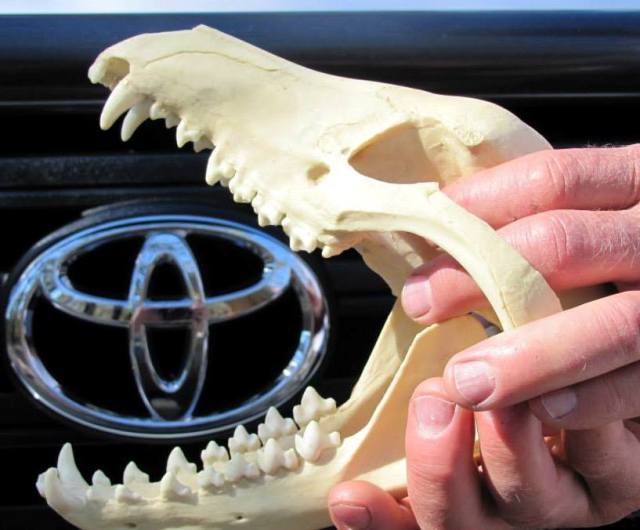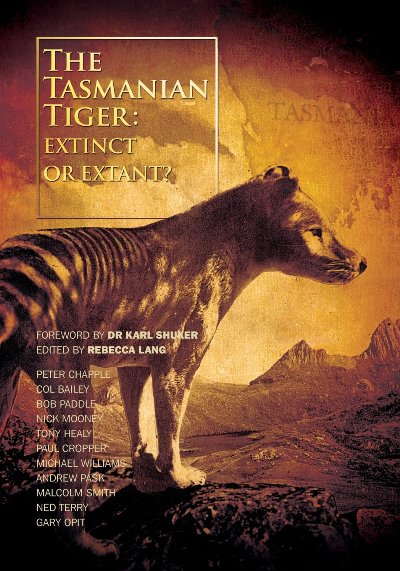The Tasmanian Tiger: Extinct or Extant?
Posted by: Craig Woolheater on December 10th, 2014
The Tasmanian Tiger: Extinct or Extant?
Paperback: 186 pages
Publisher: Strange Nation Publishing (November 20, 2014)
Language: English
ISBN-10: 0646926349
Does the Tasmanian Tiger still roam the island state, parts of the Australian mainland, and the northern land mass of Irian Jaya-Papua New Guinea? Despite being hunted to extinction in the early part of the 20th century, the Tasmanian Tiger continues to stalk the imaginations of people the world over. What’s more, hundreds of reports of the striped dog-like marsupial with the fearsome gaping jaw are made each year in Australia. In
The Tasmanian Tiger: Extinct or Extant?, biologists, geneticists, naturalists, and academics explore the evidence for and against the continuing existence of Thylacinus cynocephalus.
From author Rebecca Lang:
The last Thylacine in captivity died on September 7, 1936, ironically just two weeks shy of the species receiving protection status. In 1986, 50 years later, it would be declared extinct. By international standards it no longer exists, and is just another marsupial ghost haunting the Australian landscape following European settlement.
While Benjamin is often symbolically referred to as ‘The Last Thylacine’, in all likelihood the species persisted in the Tasmanian wilderness well into the 1930s, possibly until the 1950s. In 1980 then-Tasmanian Parks and Wildlife officer Steven Smith conducted a detailed study of sightings between 1934 and 1980, concluding of the 320 sightings, just under half could be considered good, if inconclusive.
Judging by the thousands of sightings logged by government departments and private research groups since that time, however, it may still roam remote parts of Tasmania.
Interestingly, reports also hail from unlikely mainland locations including corners of south-west Victoria and south-west Western Australia, and from as far afield as NSW and Queensland. Up north and across the Arafura Sea, indigenous people report sightings of a strange striped dog-like creature, prompting speculation that the Thylacine still dwells in the rainforests and highlands of Irian Jaya, where new species are still being discovered.
So is it or isn’t it still out there?
Like many the world over, I’ve always been intrigued by the idea that out there, somewhere, the Thylacine still prowls the far reaches of Australia’s vast southern wilderness, slipping between light and shadow, camouflaged amid dappled vegetation thanks to its distinctive dark stripes and brackish fur.
I’ve been collecting and investigating reports of alleged Thylacines on and off for many years on both the mainland and in Tasmania – most recently during a series of expeditions generously sponsored by Toyota Australia.

The Toyota logo with a replica Thylacine skull being held in front of it from 2013
One of the very first reports I collected was back in 2000 and took place in Western Australia. I was working as a journalist at the time when a woman contacted me about her 1970s sighting. Her family had been crossing the Nullarbor Plain when they saw not one but several Thylacines (a family?) wander past their car during a rest break. The sighting occurred several years after the 1966 discovery of a remarkably ‘fresh’ looking carcass discovered in a cave nearby, the so-called ‘Nullarbor Thylacine’ discussed in detail in Chapter 8.
My mind boggled at the prospect of Thylacines outside of Tasmania. I knew so little about the animals at that stage it seemed highly improbable, if not impossible. And yet the deeper I have delved into the subject, the more frequently such mainland reports have cropped up. Could it be that the Thylacine, which also once roamed the length and breadth of Australia and Irian Jaya/Papua New Guinea, has held some ground after all against the tide of extinction?
Of course one must take some of these reports with a grain of salt. There have been Thylacine sightings within 30km of my home in the Blue Mountains of NSW, and around the fringes of Melbourne suburbs. Could these sightings be genuine, or are they merely just the product of wishful thinking? Perhaps they are the echoes of a recent past…marsupial memories prowling the wilderness of our collective guilt-ridden subconscious over an arguably preventable extinction event. To this day there is passionate debate about the Thylacine’s continued existence in the Australian wilderness: whether the Thylacine is extinct, already gone after the loss of a sustainable breeding population; or extant and still with us in small numbers, clinging to survival.
To further this discussion, Australia’s resident experts and enthusiasts have come together in this anthology to put forward their assessments. This book shares optimistic, pessimistic and pragmatic assessments of the status of the Thylacine’s existence and possible resurrection. Academics, amateurs and scientists all share this platform, putting forward articulate and reasoned arguments.
Readers of the book will notice some crossover between the contributions as several authors explore the same famous cases, and ponder the implications for either the Thylacine’s ongoing survival or indisputable extinction.
One such case is the unconfirmed 1982 sighting of a Thylacine near the Arthur River in the State’s north-west by ranger Hans Naarding, investigated by then-Parks and Wildlife Officer, and contributor to this volume, Nick Mooney. Nick’s observations about that sighting are shared in Chapter 3.
Another concerns the 1985 photographs taken by Kevin Cameron of an alleged Thylacine, which were vigorously defended by West Australian zoologist Athol Douglas and featured in New Scientist magazine. The case is explored in detail (sans photographs) in Chapter 4 by Tony Healy and Paul Cropper.
I would like to thank all of the authors featured in this anthology who have enthusiastically embraced the idea, and given their time to contribute to this project – including Col Bailey, Bob Paddle, Nick Mooney, Tony Healy, Paul Cropper, Michael Williams, Andrew Pask, Malcolm Smith and Gary Opit.
I’d also like to thank the families of Ned Terry and Peter Chapple who have graciously given us permission to reprint their contributions. Special mention must also go to Dr Karl Shuker for generously agreeing to write the foreword. This book has been a labour of love, and part of the proceeds will be directed towards conservation efforts for the Tasmanian devil, the irascible and gravely endangered cousin of the thylacine.
So is the Tasmanian Tiger extinct or extant?
Have a read and let me know what you decide.
About Craig Woolheater
Co-founder of Cryptomundo in 2005.
I have appeared in or contributed to the following TV programs, documentaries and films:
OLN's Mysterious Encounters: "Caddo Critter", Southern Fried Bigfoot, Travel Channel's Weird Travels: "Bigfoot", History Channel's MonsterQuest: "Swamp Stalker", The Wild Man of the Navidad, Destination America's Monsters and Mysteries in America: Texas Terror - Lake Worth Monster, Animal Planet's Finding Bigfoot: Return to Boggy Creek and Beast of the Bayou.









